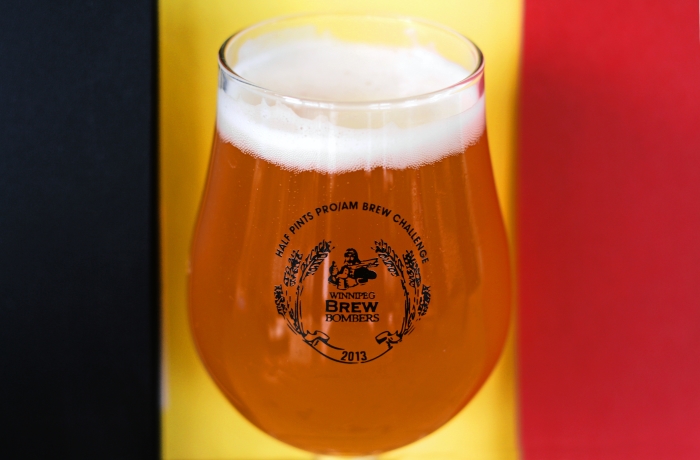At a band practice, I gave our drummer, Howard Kowalchuk, one of my home brewed beverages. He asked me what it was and I explained it was a saison, and the beer zealot in me started to ramble on about how the saison was a seasonal beer, made by Belgian farmers in the winter to give to farm hands in the summer after a hard day’s work in the field. “So, it’s not the good stuff?” Kowalchuk said. I’m not sure if he meant ‘historically speaking’, or that my beer was poor.
This traditional beverage was just meant to be a thirst quencher: low alcohol, dry, fruity and tart. It definitely progressed over the years, especially with better control of the yeast, and it has become more and more popular, especially in North America.
A yearly tradition of the Winnipeg Brew Bombers is the ‘Club Brew’ where we give each member the same ingredients for a particular style of beer and they go off and brew the beer with their own equipment. We meet a few months later to judge the beers and see if there are any differences in taste (usually there are, drastically so). This year we decided to do a saison.
Last year, we did a lager and that proved difficult for some of the newer members because of the rigid temperature control that it required. Saison’s need warmer temperatures to provide the estery (fruity) aroma and flavour that comes from the yeast. This can be achieved with heating blankets or by keeping it close to your heat register.
At The WBB’s last meeting, we had a Skype chat with Mike Tonsmeire, consultant at Modern Times Brewery based out of San Diego, and writer of the blog www.themadfermentationist.com. Just do an Internet search on sour beer and his name will pop up more than once. We were honoured to have him chat with us.
Tonsmeire explained that the main focus of this beer is the yeast, which gives the saison its signature spicy, fruity taste. Spices and other additions, such as coriander, pepper, orange rinds, and flowers are often added but should not dominate the beer. “If you can tell what spice was added, you put too much in,” Tonsmeire said.
He added that the saison can vary drastically from brewer to brewer and even from season to season. “Saison means season in French, the language of Wollonia where the style originated. So it seems appropriate to brew different saisons to drink during each seasons. To me, summer calls for a refreshing straw-yellow tart low-alcohol saison. Fall can incorporate warming spices, moving a few shades darker and stronger. Winter is the time for strong saisons, either dark or light, to chase away the chill. Spring brings with it the desire for brightly hoppy or floral saisons.”
We are encouraging all the WBB members to ‘channel their inner Belgian’ and take the basic saison recipe and make it their own. If you like saisons, give this one a try.
Club Saison
- 2.9 kg Pilsner Malt
- 1.4 kg Wheat Malt
- .5 kg Vienna Malt
- .007kg Caararoma
- 41 g Hallertau @ 60 min
- 36 g Saaz hops @ 10 min
- 15 g Hallertau hops @ 0 min
- 15 g Saaz hops @ 0 min
Wyeast 3711 (French Saison) or Wyeast 3726 (PC Farmhouse Ale)
This recipe assumes 70% brewhouse efficiency for 21.5 liters of wort.
–
I went through Tonsmeire’s blog for other ingredients he has used in saisons:
- Valencia oranges
- A sprig of rosemary
- Blackened raisins
- Buckwheat honey (recommended to go easy on this full flavoured honey)
- Black cardamom seeds
- Dates toasted and deglazed with wort and red wine
- Anise
- Cinnamon
- Fig puree
- Various types of sugar (darker sugars belong in darker beers)
- Various flowers such as jasmine or lavender
He was also fond of dry hopping Amarillo hops and other Pacific Northwest hops (citrusy) to add to the flavour profile. Citrusy hops added to the already estery beer lends a nice dynamic taking it to another level of fruit sensation.
The beauty of this beer is if you add saison yeast, it automatically becomes that style of beer. I would just be careful not to add dark, roasted malts as their acrid flavour will clash with the fruity esters. If you wanted to use roasted malts for colour, the best way to achieve this is to cold steep the grains in a coffee press and add the water to the boil kettle.
[related_content slugs=”how-to-start-home-brewing,pumpkin-beer-is-here,manitobas-first-proam-brew-challenge” description=”More Borowski on Beer” position=”right”]
If you are new to the world of the saison, Granville Island Brewing makes a Thirsty Farmer Saison that sits at 6.2% ABV and is quite refreshing, and Half Pints has released the Saison De La Ceinture during Festival du Voyager for the past two years. I always try to get a few bottles of that before they sell out.
Next Week: I’ll detail a step-by-step process for brewing an all-grain batch of beer.
–
Mark Borowski is a home brewer, and a father, and is looking for a job as a bartender. Follow him on Twitter @oldblackbrew
